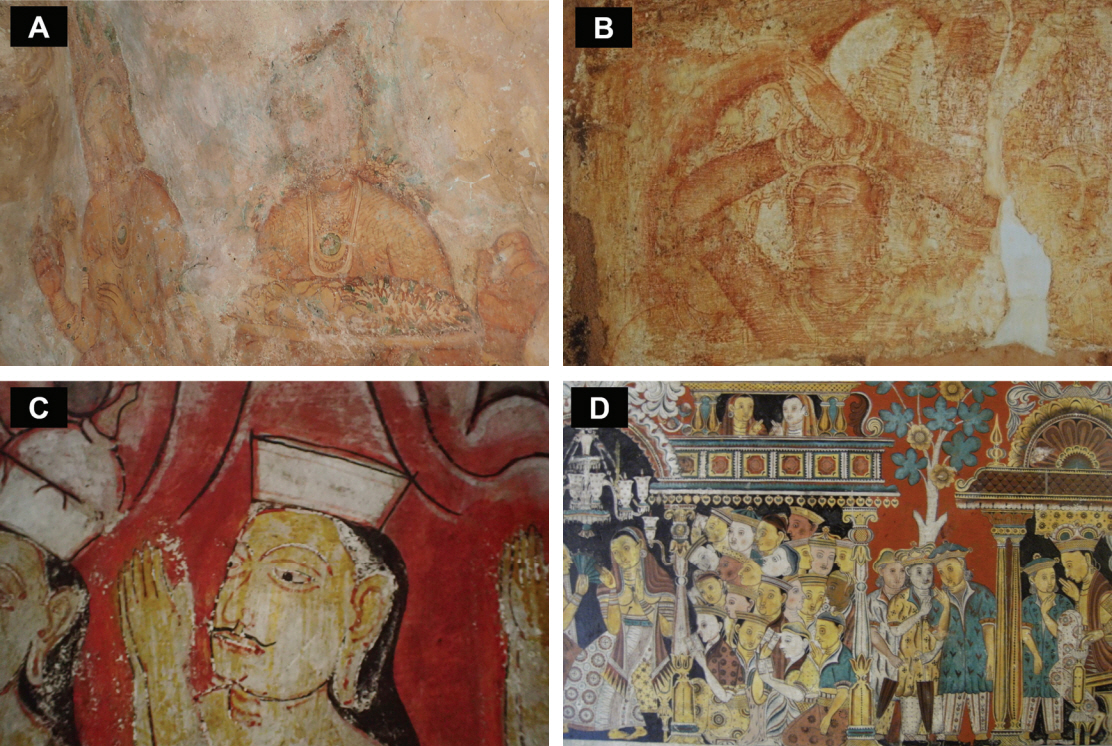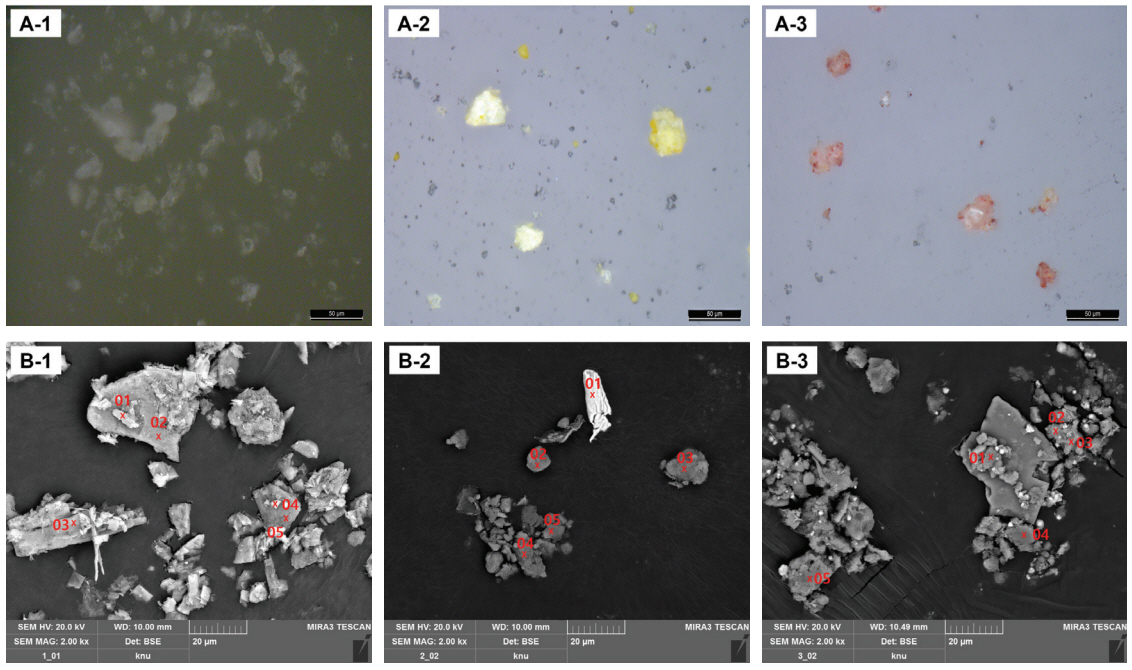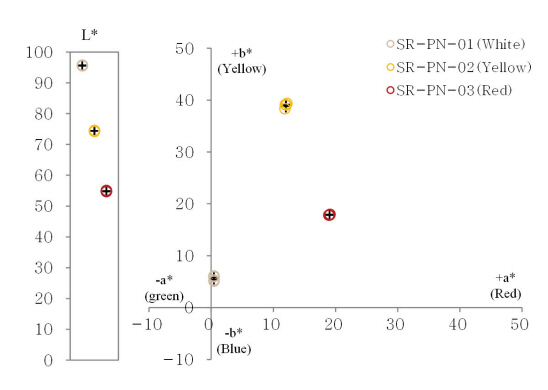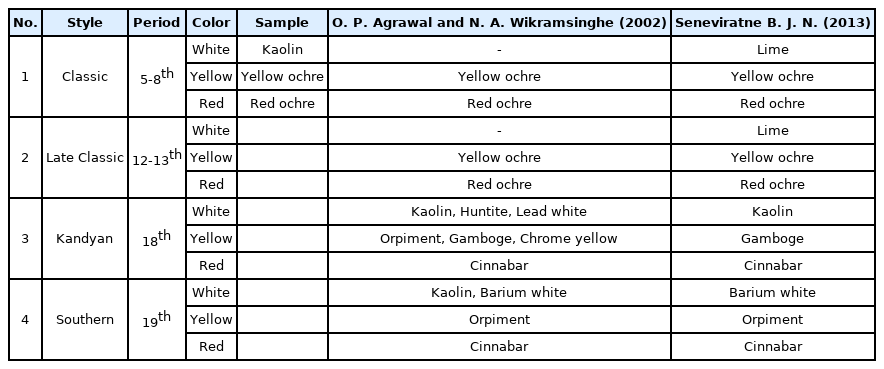A Characteristic Analysis on Clay Pigments of Mural Paintings in Sri Lanka
Article information
Abstract
Sri Lanka has four types of mural painting styles; Classic, Late Classic, Kandyan, and Southern styles, but there is little research on scientific analysis for mural paintings. In this study, we analyze white, yellow, and red clay pigments which were collected from ancient producing sites. Analyzing pigment samples shows that samples are containing aluminum oxide(Al2O3) and silicon dioxide(SiO2) which are connected to the soil. And a degree of iron oxidation determines yellow or red colors. To understand the characteristics of clay pigment samples, we go over previous pigment analyses of mural paintings in Sri Lanka. Kaolin is identified after the 17th century, yellow and red ochre are applied in early periods, Classic and Late Classic styles. The change in raw materials of pigments occurred in the 17th century.
1. INTRODUCTION
Mural painting is a reflection of culture, religion, and perspective of life at the time. It has been used as a decoration for walls, buildings, or caves since the paleolithic period. People used to get pigments that they can easily access, and the several pigments which can collect from nature followed as; Lead white (2PbCO3⋅Pb(OH)2), Calcite (CaCO3), Kaolin (Al2O3⋅2SiO2⋅2H2O), Yellow ochre, Orpiment (As2S3), Red ochre, Cinnabar (HgS), and Red lead (Pb3O4), etc.
Sri Lanka is famous for its variety of mural paintings which have their own styles from the 5th to 19th centuries. The ancient cities flourished in the center and south-western region, and 41 mural paintings have been found around the cities. As kingdoms grow, the contents, expressions, materials, and techniques of mural paintings have developed based on their cultures. The styles of mural painting in Sri Lanka are categorized by period; Classic (2nd-13th century A.D.), Late Classic (10th-13th century A.D.), Kandyan (17th-18th century A.D.), and Southern (late 18th century A.D.) (Seneviratne, 2013).
One of the famous mural paintings in Classic style is the Ancient city of Sigiriya. It is popular because of the Lion Rock Fortress and huge gardens, but also the mural paintings. Even though Buddhism has prevailed, the nymph or Apsara (a female spirit of the clouds and water in Hinduism) was painted on Sigiriya. It assumed that those features were affected by coup d’État of Kashayapa Ⅰ. And lots of research has been continued because the painting has artistic and historical values.
In the 11th century, the Polonnaruwa kingdom had been established by immigrants of the Chola dynasty, India. However, in the 12-13th century, Sinhalese got back to the major group in Sri Lanka, and the Late Classic style was succeeding the Classic style. Tiwanka Image House has typical contents, drawing techniques, lines, and forms of the Late Classic.
The Kandyan kingdom had been impacted by near countries a lot; Tamil, Thai, and Myanmar. And it has strict rules for lines and colors. Rangiri Dambulla Cave Temple is one of the famous Kandyan mural paintings. Southern style is a local culture in the 18th century. Because the trading with Western was stimulated, the Southern style has Western and Sri Lankan at the same time. Any research has not been performed in Kathaluwa Puwarama Viharaya, but the colors, lines, and contents of this mural show typical style.
Scientific analysis and research have been going on by a few researchers in Sri Lanka. Agrawal and Wikaramsinghe (2002) introduced materials and techniques in India that have influenced Sri Lanka. They also analyzed 20 mural paintings and organized general information on mural painting in Sri Lanka. Seneviratne (2013) analyzed mural samples and binding materials by XRF, XRD, SEM-EDS, FT-IR, and GC/MS to understand the techniques of paintings. Also, Seneviratne (2018) arranged the materials for mural painting in Sri Lanka, Korea, and Myanmar and revealed the techniques applied in mural paintings. Thantilage et al. (2017) are focused on revealing the red pigments used in the Kandyan murals. They organized the ancient literature and research that connected to red pigments and revealed that red pigment was used in order of Iron oxides, Cinnabar, and Red lead in Kandy period. The investigators revealed that the ancient painters used different materials for each style. According to mentioned research, they found that pigments that were applied to mural paintings are changed as styles. Lime (CaCO3), Yellow ochre, and Red ochre have been identified in Classic and Late Classic styles. On the other hand, Kaolin, Barium white (BaSO4), Orpiment (As2S3), Massicot (PbO), Gamboge, Cinnabar (HgS), and Red lead have been detected in Kandyan and Southern styles (Agrawal and Wikaramsinghe, 2002; Seneviratne, 2013).
This study analyzed the clay pigments that were referred to an ancient production site for a long time. The data were compared with the results of mural pigment analysis, and it can be applied to set the analytical methods and further research.
2. ANALYSIS SUBJECT
The pigments which were analyzed in this paper are white, yellow, and red color used in common (Table 1., Figure 1, 2.). The producing area of clay pigment was selected according to Seneviratne B. J. N. who is a researcher at the department of archaeology in Sri Lanka. These areas have been known as traditional sites of clay pigments, and each pigment was collected from the subsoil layer. It is near Horton Plains National Park where 57 woody species belonging to 31 families have been encountered where 50% are endemic to Sri Lanka (Premathilake and Nilsson, 2001).

The images of pigment samples selected in this study; A: SR-PN-01(White), B: SR-PN-02(Yellow), C: SR-PN-03(Red).

The images of mural paintings in Sri Lanka; (A): Rock of Sigiriya (Classic style), (B): Polonnaruwa Tiwanka Image House (Late Classic style), (C): Rangiri Dambulla cave temple (Kandyan style), (D): Kathaluwa Purwarama Viharaya (Southern style). (B) and (D) are provided from Seneviratne B.J.N. (2013).
O. P. Agrawal and N. A. Wikaramsinghe (2002) deduced an elutriation process of Sri Lanka based on Indian ancient literature. The process is as follows; First, Collect fine sands or clays nearby a river and middle of the forest. Second, Clean the materials with clear water and grind them. Third, Pour water and use floating particles for pigments. Since the process is similar to the Korean traditional way, we refer to Kang, et al. (2016; 2017) and Mun, et al. (2019).
3. ANALYSIS METHOD
The optical microscope (NM910, Nexcope, USA) is used to observe and compare the dispersed pigment particles. The colorimetric analysis is performed by spectrophotometer (CM-700d, Konica Minolta, JPN). The data are expressed as CIELAB which shows as Lightness (L*) and chromaticity (a* stands for red-green and b* stands for yellow-blue). Also, the data are measured with D65 illumination source and 10° observer angle. Elemental analysis is operated by a portable X-ray Fluorescence spectrometer (SEA 200, Seiko, JPN). The spot size is 2 mm, the acceleration voltage and current are maximal 50 kV and 200 μA, and the exposure time is 300 seconds. Pigment analysis and observation were operated by energy dispersive X-ray spectroscopy (Qunatax, Bruker, GER) equipped with scanning electron microscopy (MIRA3-LMH, Tescan, CZE). Samples were coated with platinum (Pt), and results are performed at 20 kV under backscattered electrons (BSE) mode and 120 seconds of exposure time. X-ray diffraction analysis is performed with Miniflex600 (Rigaku, JPN). The diffraction patterns are recorded at 40 kV, 15 mA, and a scanning range of 5°-80°.
4. RESULTS OF ANALYSIS AND CONSIDERATION
Table 2 is shown the mean and standard deviation of chromaticity measured 5 times. Clay pigment samples have distinguishable colors. The lightness and chromaticity of each sample are similar to color which is perceived by the human eyes (Figure 3). Optical microscope images of grains show that samples contain grains or particles which determine colors. SR-PN-01 (White) contains dispersed white-transparent grains, SR-PN-02 (Yellow) is composed of yellow and white grains, and SR-PN-03 (Red) contains transparent grains which are surrounded by small red particles.
In the XRF, the clay pigment samples are different in the intensity of Potassium and Iron (Table 3). SR-PN-01 contains Potassium which can be connected to earth elements. On the other hand, SR-PN-02 and 03 contain Iron which is a key element for red pigments, especially Iron oxide pigments. The results of SEM-EDS show that Al2O3 and SiO2 are contained in samples (Table 4). Those compounds can be connected to Kaolin, Orthoclase, and Quartz. Particles of SR-PN-01 contain high K2O. SR-PN-02 and 03 have bright particles which are composed of Fe2O3 (Figure 4). XRD patterns of pigment samples show that all samples contain clay minerals; Kaolinite, Orthoclase, Muscovite, and Quartz (Figure 5). As a result, clay minerals are substituted for the three clay pigment samples in this study. And we can consider that the divisible colors of the pigment samples are determined by a degree of oxidation on Iron oxides.

Images of optical microscope (A) and Backscattered electron(BSE) mode in SEM(B); (1): SR-PN-01(White), (2): SR-PN-02(Yellow), (3): SR-PN-03(Red).

XRD patterns of clay pigment samples in this study; K: Kaolinite, O: Orthoclase, M: Muscovite, Q: Quartz.
In this paper, we compared the results of pigment analysis between the collected samples and research byAgrawal and Wikaramsinghe (2002); Seneviratne (2013) (Table 5). The era of mural paintings is suggested by historical documents, studies, and painting styles. Kaolin appeared in mural paintings of Kandyan and Southern styles which were flourishing in the 18-19th century. Not only Kaolin, but Huntite, Lead white, and Barium white have been identified. On the other hand, yellow and red pigment samples are connected to Classic and Late Classic styles. The differences occur in the 17th century. But, unlike yellow and red, the research on white of Classic and Late Classic styles is lacking. Further investigation is necessary to determine the duration of Kaolin.
5. CONCLUSION
Mural paintings have been used for the decoration of buildings, and they contain valuable contents and techniques for centuries. Sri Lankan researchers have tried to preserve mural paintings through various investigations and scientific analyses. This study obtained clay pigments from pigment-producing sites since ancient times. After the elutriation process, clay pigment samples were analyzed to understand the scientific characteristics.
We found that pigment samples contained clay minerals and revealed the color of clay pigments is affected by a degree of oxidation of Iron oxides. Compared to previous investigations of pigments on mural paintings in Sri Lanka, yellow and red clay pigments were applied before the 17th century and white clay pigment is identified after that. The raw materials of pigments changed in the 17th century.





